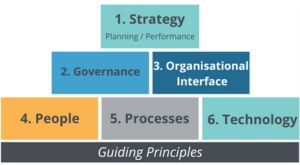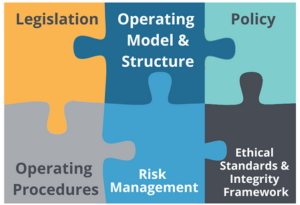Mastering procurement: Governance
By Peter Morichovitis, Principal Advisor Procurement Office and Professional Advisory
Councils can differ greatly in their procurement maturity. Some councils may be starting out on a journey to improve their procurement function, whilst others may have been on the journey for numerous years, having reached a greater level of procurement maturity and performance.
Regardless of the size of your council, the size or maturity of the procurement team; there are six key building blocks to enhancing local government procurement. If you structure your procurement improvement efforts around these six blocks, you can develop and execute a simple and practical design to improve procurement capability and enable procurement value within the organisation.
Six Building Blocks to Enhance Local Government Procurement
Primarily, from the 'top down', the right procurement strategy, associated plans and performance measurement methods need to be built to drive the procurement function. The second row of blocks enables a direct link to the wider council organisation through a procurement governance framework and the management of the organisational interface, particularly with internal customers, executives and suppliers. All upon a foundational layer of people, processes, and technology, built upon your council’s core values and guiding principles.
Today, we are going to focus on mastering “procurement governance”.
Mastering Procurement Governance
 What is procurement governance?
What is procurement governance?
Procurement governance encompasses control and direction for an organisation’s procurement function via a framework of formal structures, mandates, policies, operating procedures, delegations and other decision-rights. Procurement governance is essential in building procurement capability and ensuring the benefits from strategic procurement activities are maximised council-wide, as well as keeping the auditors at a distance.
Governance is not new to your council. There are many other areas of governance, for example, finance, HR, ICT, planning, WHS and risk management.

The Procurement Governance Framework
There are 6 essential components to a Procurement Governance Framework.
1.Legislation
Procurement is one of the most legislated functions within local government. The obvious ones come to mind, being the Local Government Act 2009 and the Local Government Regulation 2012. However we must not forget others including the Public Sector Ethics Act 1994 (Qld), Competition and Consumer Act 2010 (Cth), Fair Trading Act 1989 (Qld), Crime and Corruption Act 2001 (Qld), Work Health and Safety Act 2011 (Qld), Environmental Protection Act 1994 (Qld), Information Privacy Act 2009 (Qld), Right to Information Act 2009 (Qld), Human Rights Act 2019 (Qld) and Building Industry Fairness (Security of Payment) Act 2017 (Qld). And this list is not exhaustive.
This and other legislation needs to be operationalised through the Procurement Governance Framework to ensure compliance. This is done through the implementation of good policies, procedures, tendering conditions, evaluation processes, contract T&C’s, and performance measures and reporting, for example.
2. Operating Model and Structure
Firstly, procurement needs to be integrated into the overall council strategic planning process and secondly, the optimum procurement organisational structure needs to be executed.
Our recent webinar attendees indicated that 38% had a centre-led procurement structure, 33% were decentralised and 23% were centralised. The right procurement organisational structure for a council (similar to the right procurement strategy) is dependent on that council’s strategic objectives, goals and values, coupled with the maturity level of its procurement function. A centralised structure is typically more favourable for a young, greenfield or immature procurement function, or where a rapid procurement transformation is required. Where the procurement function is of greater maturity and a robust governance model has been institutionalised to the degree that the corporate culture supports the model, then moving to centre-led or decentralisation is probably the way to go.
3. Policy
Yes, it is a statutory requirement for a council to have a procurement policy (s198 Local Government Regulation 2012). More so, for procurement to be successful; procurement policies that are simple, based on a compelling business case, and consistent with the corporate culture need to be operative. As is a clear, council-wide mandate to comply with the procurement policies.
In addition to an overall procurement policy, it is good practice to also have specific procurement policies in place to support specific procurement strategies (e.g. buying locally, supporting Indigenous businesses, sustainability and supplier codes of conduct).
Furthermore, consider how you will incorporate the wider council policies into your procurement policy and processes. For example, Code of Conduct, Benefits and Gifts Policy, Delegation Policy, Work Health and Safety Policy, Information Privacy Policy etc.
4. Operating Procedures
Procurement operating procedures need to be commensurate with your council’s documentation standards. Good practice is having three levels of procurement procedural documentation.
a) Description of key processes: such as Standard Operating Procedures (SOPs), Work Instructions and process flows.
b) Governance enablers: for example; Delegations Register, Contracts Register and documented internal controls (e.g. segregation of duties, approval hierarchies, audit trails).
c) Value-adding docs: roles and responsibilities; tools, templates and forms; checklists; and measures and reporting mechanisms (internal and external).
5. Risk Management
You don’t need to ‘reinvent the wheel’ here. Just use your council’s risk management framework and apply it to a procurement context.
A procurement risk assessment should be is a living document throughout an end-to-end procurement process, commencing with the procurement planning and then revisited and updated during the evaluation process, after the contract is executed and during contract management.
6. Ethical Standards and Integrity Framework
Likewise, the wheel does not need to be reinvented to develop a procurement Ethical Standards and Integrity Framework. Leverage off your existing council artifacts; for example, in relation to ethical decision making, transparency, conflict of interest management, code of conduct, human rights, confidentiality, whistle-blower protection, fraud and corruption prevention, gifts and benefits, information privacy, right to information, to name a few.
The one area you will need to pay special attention to is ‘probity’. For more on probity, catch our most recent webinar #3
What does good Procurement Governance look like?
The following characteristics are associated with successfully implementing a Procurement Governance Framework and thus laying the “governance” building block in order to enhance procurement capability.
-
Procurement expertise is across all addressable external spend.
- A Procurement Governance Framework consistent with the organisational culture is in place.
- The Procurement Governance Framework ensures adherence to laws, acts and regulations.
- Socially responsible procurement is enabled through the governance framework.
- The Procurement Operating Model/Structure supports the culture, objectives and maturity of the organisation and procurement function.
- Procurement is integrated into the Council-wide strategic planning process.
- A well-documented Procurement Policy outlines objectives, principles, and ethical standards.
- Specific procurement policies that are simple and based on corporate objectives are operative (e.g. Indigenous engagement, buying local, sustainability, innovation).
- Value for money and risk are balanced in decision making and risk management underpins the procurement processes.
- A clear, corporate mandate to comply with procurement policies and procedures is operative.
- Effective change management has resulted in the corporate culture supporting the Procurement Governance Framework.
- A formal approval framework specifies the authorisation process for procurement spend, speeding up timelines without compromising controls.
- Corporate systems have appropriate controls embedded which support the procurement governance model.
- Procurement personnel are empowered to make decisions on behalf of the council in accordance with the policies.
- Procurement decisions are based on ethical principles including probity, fairness, impartiality, accountability and transparency; can be traced and justified.
- Regular audits and reporting is conducted to track performance and compliance.
- Procurement processes, systems, tools and techniques are documented, referenced and maintained as operating procedures, consistent with the council standards.
- Regular training is provided on probity, procurement policies, procedures, and best practices to all staff involved in procurement activities.
Conclusion
Mastering procurement governance is a continuous journey that requires dedicated effort by procurement professionals in local government. By developing a comprehensive Procurement Governance Framework, councils can achieve excellence in their procurement function and maximise value to their stakeholders.
If your Council would like any further information or support in developing a Procurement Governance Framework, please contact Peak Consulting, Procurement Office at procurement@wearepeak.com.au, or reach out to Peter Morichovitis at pmorichovitis@wearepeak.com.au